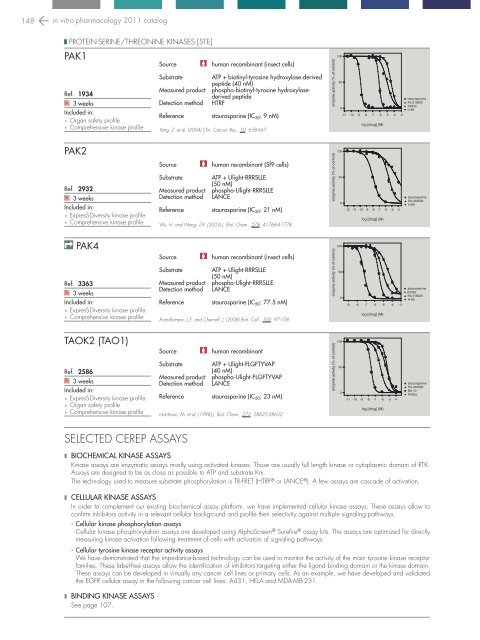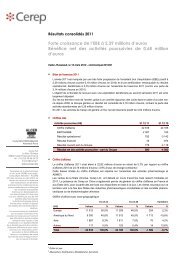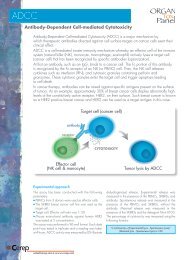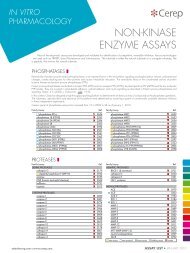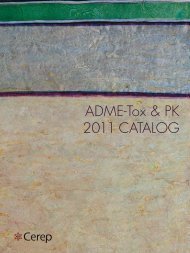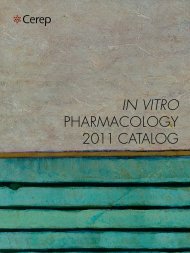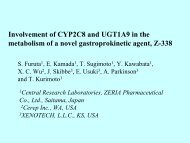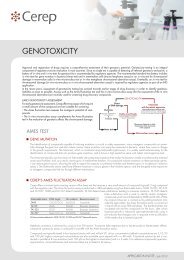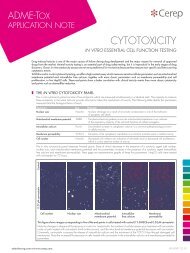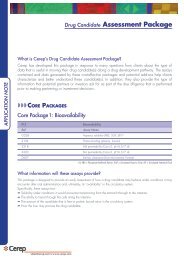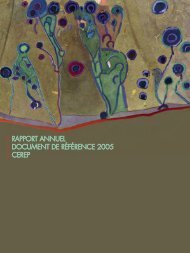in vitro PHARMACOLOGY 2011 CATALOG - Cerep
in vitro PHARMACOLOGY 2011 CATALOG - Cerep
in vitro PHARMACOLOGY 2011 CATALOG - Cerep
Create successful ePaper yourself
Turn your PDF publications into a flip-book with our unique Google optimized e-Paper software.
148 <strong>in</strong> <strong>vitro</strong> pharmacology <strong>2011</strong> catalog<br />
❚ prote<strong>in</strong>-SERINE/THREONINE k<strong>in</strong>ases [STE]<br />
PAK1<br />
Ref. 1934<br />
Q 3 weeks<br />
Included <strong>in</strong>:<br />
Organ safety profile<br />
Comprehensive k<strong>in</strong>ase profile<br />
Source<br />
human recomb<strong>in</strong>ant (<strong>in</strong>sect cells)<br />
Substrate ATP + biot<strong>in</strong>yl-tyros<strong>in</strong>e hydroxylase-derived<br />
peptide (40 nM)<br />
Measured product phospho-biot<strong>in</strong>yl-tyros<strong>in</strong>e hydroxylasederived<br />
peptide<br />
Detection method HTRF<br />
Reference<br />
staurospor<strong>in</strong>e (IC 50 : 9 nM)<br />
Yang, Z. et al. (2004) Cl<strong>in</strong>. Cancer. Res., 10: 658-667.<br />
enzyme activity (% of control)<br />
100<br />
50<br />
0<br />
-11 -10 -9 -8 -7 -6 -5 -4<br />
log [drug] (M)<br />
staurospor<strong>in</strong>e<br />
Ro-318220<br />
K252a<br />
H-89<br />
-3<br />
PAK2<br />
Ref. 2932<br />
Q 3 weeks<br />
Included <strong>in</strong>:<br />
ExpresS Diversity k<strong>in</strong>ase profile<br />
Comprehensive k<strong>in</strong>ase profile<br />
Source<br />
human recomb<strong>in</strong>ant (Sf9 cells)<br />
Substrate ATP + Ulight-RRRSLLE<br />
(50 nM)<br />
Measured product phospho-Ulight-RRRSLLE<br />
Detection method LANCE<br />
Reference<br />
-10<br />
staurospor<strong>in</strong>e (IC 50 : 21 nM)<br />
Wu, H. and Wang, Z-X. (2003) J. Biol. Chem., 278: 41768-41778.<br />
-9 -8 -7 -6 -5 -4<br />
<br />
<br />
-10 -9 -8 -7 -6 -5 -4 -3<br />
-8 -7 -6 -5 -4<br />
-10 -9 -8 -7 -6 -5<br />
-9 -8 -7 -6 -5 -4<br />
<br />
-10 -9 -8 -7 -6 -5<br />
<br />
<br />
<br />
<br />
<br />
<br />
PAK4<br />
Ref. 3363<br />
Q 3 weeks<br />
Included <strong>in</strong>:<br />
ExpresS Diversity k<strong>in</strong>ase profile<br />
Comprehensive k<strong>in</strong>ase profile<br />
Source<br />
human recomb<strong>in</strong>ant (<strong>in</strong>sect cells)<br />
Substrate ATP + Ulight-RRRSLLE<br />
(50 nM)<br />
Measured product phospho-Ulight-RRRSLLE<br />
Detection method LANCE<br />
Reference<br />
staurospor<strong>in</strong>e (IC 50 : 77.5 nM)<br />
Arias-Romero, L.E. and Chernoff, J. (2008) Biol. Cell., 100: 97-108.<br />
<br />
<br />
<br />
<br />
<br />
<br />
<br />
<br />
<br />
<br />
<br />
<br />
<br />
<br />
<br />
<br />
<br />
<br />
<br />
<br />
TAOK2 (TAO1)<br />
Ref. 2586<br />
Q 3 weeks<br />
Included <strong>in</strong>:<br />
ExpresS Diversity k<strong>in</strong>ase profile<br />
Organ safety profile<br />
Comprehensive k<strong>in</strong>ase profile<br />
Source<br />
human recomb<strong>in</strong>ant<br />
Substrate ATP + Ulight-FLGFTYVAP<br />
(40 nM)<br />
Measured product phospho-Ulight-FLGFTYVAP<br />
Detection method LANCE<br />
Reference<br />
<br />
<br />
<br />
staurospor<strong>in</strong>e (IC 50 : 23 nM)<br />
Hutchison, M. et al. (1998) J. Biol. Chem., 273: 28625-28632.<br />
<br />
<br />
<br />
<br />
<br />
<br />
<br />
<br />
<br />
<br />
<br />
<br />
<br />
<br />
<br />
<br />
<br />
selected cerep assays<br />
<br />
<br />
<br />
❚ Biochemical k<strong>in</strong>ase assays<br />
<br />
<br />
K<strong>in</strong>ase assays are enzymatic assays mostly us<strong>in</strong>g activated k<strong>in</strong>ases. Those are usually full length k<strong>in</strong>ase or cytoplasmic doma<strong>in</strong> of RTK.<br />
Assays are designed to be as close as possible to ATP and substrate Km.<br />
<br />
The technology used to measure substrate phosphorylation is TR-FRET (HTRF ® or LANCE ® ). A few assays are cascade of activation.<br />
<br />
❚ Cellular k<strong>in</strong>ase assays<br />
<br />
In order to complement our exist<strong>in</strong>g biochemical assay platform, we have implemented cellular k<strong>in</strong>ase assays. These assays allow to<br />
confirm <strong>in</strong>hibitors activity <strong>in</strong> a relevant cellular background and profile their selectivity aga<strong>in</strong>st multiple signal<strong>in</strong>g pathways.<br />
- Cellular k<strong>in</strong>ase phosphorylation assays<br />
Cellular k<strong>in</strong>ase phosphorylation assays are developed us<strong>in</strong>g AlphaScreen ® Surefire ® assay kits. The assays are optimized for directly<br />
measur<strong>in</strong>g k<strong>in</strong>ase activation follow<strong>in</strong>g treatment of cells with activators of signal<strong>in</strong>g pathways.<br />
- Cellular tyros<strong>in</strong>e k<strong>in</strong>ase receptor activity assays<br />
We have demonstrated that the impedance-based technology can be used to monitor the activity of the ma<strong>in</strong> tyros<strong>in</strong>e k<strong>in</strong>ase receptor<br />
families. These label-free assays allow the identification of <strong>in</strong>hibitors target<strong>in</strong>g either the ligand b<strong>in</strong>d<strong>in</strong>g doma<strong>in</strong> or the k<strong>in</strong>ase doma<strong>in</strong>.<br />
These assays can be developed <strong>in</strong> virtually any cancer cell l<strong>in</strong>es or primary cells. As an example, we have developed and validated<br />
the EGFR cellular assay <strong>in</strong> the follow<strong>in</strong>g cancer cell l<strong>in</strong>es: A431, HELA and MDA-MB-231.<br />
❚ B<strong>in</strong>d<strong>in</strong>g k<strong>in</strong>ase assays<br />
See page 107.


